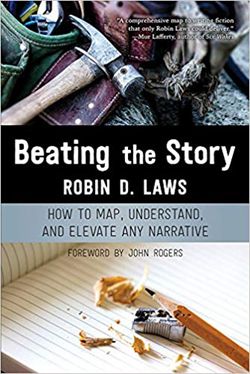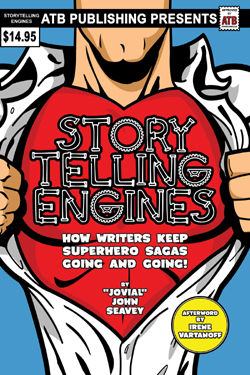My recent nonfiction reading has tended to be driven by the fact that as a writer and gamer, I’m always looking for new tools to put into my virtual toolbox. Here’s three recent reads aimed in that direction.
 Beating the Story: How to Map, Understand, and Elevate Any Narrative, Robin D. Laws. (Gameplaywright, 2018) Fans of Law’s earlier book, Hamlet’s Hit Points, will be pleased to find that this book expands upon his theory of “beats” as they relate to storytelling through gameplay and text. Beats are moments that move the story along, such as a procedural beat, which moves a hero towards or away from their goal, or a commentary beat, where movement is suspended while the author underscores a thematic element. It is not necessary to have read the earlier book to enjoy or get a lot out of this one, and if one were choosing between the two, I would opt for this one as being the more complete version of and elaboration on the overall theory, as well as being focused on writing rather than storytelling via a game campaign.
Beating the Story: How to Map, Understand, and Elevate Any Narrative, Robin D. Laws. (Gameplaywright, 2018) Fans of Law’s earlier book, Hamlet’s Hit Points, will be pleased to find that this book expands upon his theory of “beats” as they relate to storytelling through gameplay and text. Beats are moments that move the story along, such as a procedural beat, which moves a hero towards or away from their goal, or a commentary beat, where movement is suspended while the author underscores a thematic element. It is not necessary to have read the earlier book to enjoy or get a lot out of this one, and if one were choosing between the two, I would opt for this one as being the more complete version of and elaboration on the overall theory, as well as being focused on writing rather than storytelling via a game campaign.
An entertaining and lucid writer, Laws delivers a dense and meaty book with a wealth of writing advice packed into it. I know I’ll come back to it in order to go through several parts at greater length, particularly the chapters “Mapping Your Story” and “Revision.” Laws provides three case studies from Mad Men, The X-Files, and The Color Purple, as well as a worksheet for moving from inspiration to premise and a quick reference guide to concepts.
 The Postmodern Joy of Role-Playing Games: Agency, Ritual and Meaning in the Medium, René Reinhold Schallegger, (Studies in Gaming, McFarland and Company, 2018) Schallegger pulls out key concepts of postmodernism as well as basic theories of play and games and maps them against tabletop roleplaying, beginning with a definition and history of RPGs, an overview of RPG theory, a survey of some of the critical literature, and finally a list of alternative theoretical perspectives on them. This is not the most grippingly or brilliantly told explanation of postmodernism that I’ve seen, but it does a reasonable job with the requisite ritual obeisances towards Lyotard, Derrida, and Baudrillard before moving on to Scott Lash, Charles Jencks, and Ihab Hassan.
The Postmodern Joy of Role-Playing Games: Agency, Ritual and Meaning in the Medium, René Reinhold Schallegger, (Studies in Gaming, McFarland and Company, 2018) Schallegger pulls out key concepts of postmodernism as well as basic theories of play and games and maps them against tabletop roleplaying, beginning with a definition and history of RPGs, an overview of RPG theory, a survey of some of the critical literature, and finally a list of alternative theoretical perspectives on them. This is not the most grippingly or brilliantly told explanation of postmodernism that I’ve seen, but it does a reasonable job with the requisite ritual obeisances towards Lyotard, Derrida, and Baudrillard before moving on to Scott Lash, Charles Jencks, and Ihab Hassan.
Understanding these theories to talk about games seems as though it would surely be lively given the juiciness of the subject, but the prose is very dry and academic at times. I could easily see this being used as a highly serviceable text in an upper level college class or to self-educate at a similar level, but it’s hardly a pleasure read, particularly for anyone already reasonably well read in both areas. Here, for example is a random paragraph:
The ideological meta-message the medium RPG communicates through this process on both a narrative and formal level is that rules are necessary for collective decisions to work. This is why Rein-Hagen openly warns: “Don’t let luck rule the plot. Characters should get to win on the basis of their own skill and ingenuity, not on unrelated dice rolls” (1991: 230). Players need to know that the rules are fair and will be applied meaningfully, that the narrative is coherent and provides all participants with an enjoyable and meaningful experience, and that acting as a group will result in an acceptable outcome and not be rendered meaningless by a single unlucky roll of the dice. If the rules of simulation, narrative, and social interaction are rendered meaningless, what remains is chaos and disintegration. Meaning needs negotiation and at least a provisional consensus, and negotiation and consensus both need a shared framework of reference. RPGs, according to Rein-Hagen, showcase these processes of meaning-making, their necessities and dangers.
If that’s your cup of tea, you may want to check out the overall Studies in Gaming series, edited by Matthew Wilhelm Kapell and available at www.mcfarlandpub.com. Other volumes in the series include The Play Versus Story Divide in Game Studies: Critical Essays (edited by Kapell); Player and Avatar: The Affective Potential of Videogames by David Owen; Responding to Call of Duty: Critical Essays on the Game Franchise, edited by Nate Harrelts; Speedrunning: Interviews with the Quickest Gamers by David Snyder; and Storytelling in Video Games: the Art of the Digital Narrative by Amy M. Green. Forthcoming works look of interest as well.
 Story Telling Engines: How Writers Keep Superhero Sagas Going and Going!, John Seavey. (ATB Publishing, 2018) I had hoped for an overall theory that was a bit more elaborate than the one that this book delivered, but once I got over that disappointment, I relaxed and enjoyed the way Seavey takes a relatively simple set of concepts and then exhaustively applies them to comic series after comic series, over a hundred of them, including more obscure ones like Ambush Bug, She-Hulk, Adam Strange, Moon Knight, The Dazzler, Metamorpo, Bat Lash and Amethyst, Princess of the Gem World.
Story Telling Engines: How Writers Keep Superhero Sagas Going and Going!, John Seavey. (ATB Publishing, 2018) I had hoped for an overall theory that was a bit more elaborate than the one that this book delivered, but once I got over that disappointment, I relaxed and enjoyed the way Seavey takes a relatively simple set of concepts and then exhaustively applies them to comic series after comic series, over a hundred of them, including more obscure ones like Ambush Bug, She-Hulk, Adam Strange, Moon Knight, The Dazzler, Metamorpo, Bat Lash and Amethyst, Princess of the Gem World.
Seavey’s theory focuses on the idea that every open-ended series, whether based on a single character or a group, must have a “status quo.” That status quo is the series’ baseline/context and Seavey describes it as a storytelling engine, working to generate stories.
It generates those stories firstly by providing an interesting context in which stories about that context organically grow. Hogwarts, Narnia, and The Office are all examples of such contexts. Some contexts are richer than others. Another way stories can be generated through the status quo is though genuine change to it, such as the death of a major character. Or stories can be about the disruption of and subsequent return to the status quo.
Seavey takes this set of ideas and analyzes each series to see what its status quo is, how rich (or not) it was, and how it may have changed over the course of the series, each time in 4-5 pages. Readers well conversant with comics will find this an interesting and sometimes nostalgic read.
